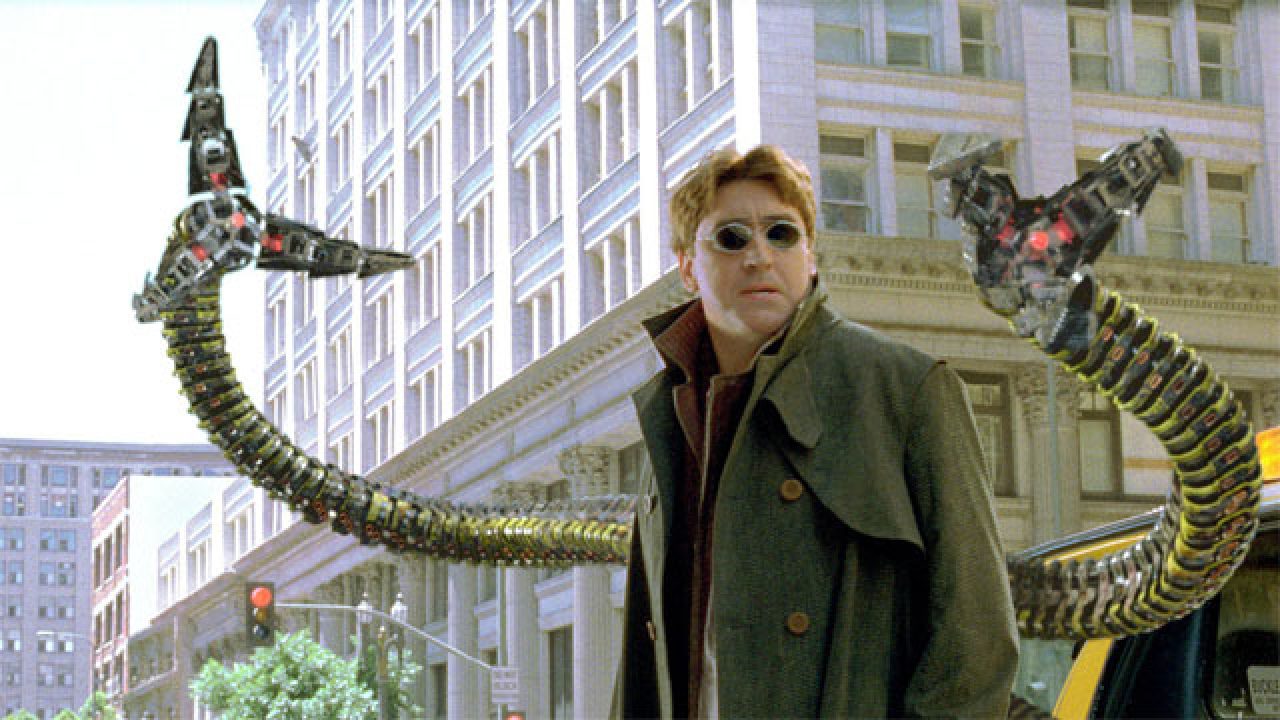Way back in 2004, many speculated Alfred Molina’s Doctor Octopus would return after Spider-Man 2, even though he ended that movie by vanishing beneath the Hudson River. This of course seemed like wishful thinking at the time: Molina might’ve been the best Spider-Man movie villain up to that point, but Sony couldn’t bring him back after he took a nuclear-heated bath, right?
Nearly 15 years and two reboots later, it turns out they could! Indeed, THR confirmed Tuesday that Molina will return as the metal-armed scientist in the Tom Holland-led, and Marvel Studios produced sequel to Spider-Man: Far From Home. The movie doesn’t have a title as of yet, but with Molina joining Jamie Foxx—who played Electro in the much less revered The Amazing Spider-Man 2 (2014)—clearly the film is going to be playing with the space time continuum, and bringing back some old favorites.
In the case of Molina, this is a good thing. While his inclusion might point to a cunning (or haphazard) backdoor into a “Sinister Six” movie, it also suggests Marvel Studios and Hollywood itself is learning to be more discerning about what needs to be rebooted for the sake of franchise continuation, and what does not.
When Spider-Man 2 came out, Molina’s Doc Ock was a breath of fresh air in superhero cinema. Willem Dafoe was, of course, perfectly cast as Spider-Man’s arch-nemesis from the comics, the Green Goblin, in the original Spidey movie from two years prior. But the movie’s depiction of the character inside that plastic green costume left something to be desired. While Dafoe was still excellent at chewing scenery as Norman Osborn, his villain kept a foot left planted squarely in the campiness of 1990s blockbusters, specifically the Batman franchise that predated director Sam Raimi’s Spider-Man.
With Molina’s Doc Ock, however, Raimi and the actor crafted a compelling villain who married the zaniness of early Stan Lee and Steve Ditko comics, and its mad scientist authority figures who wanted to take over/destroy the world depending on the issue, and a character actor’s ability to make a meal out of what could be a thin part. The film’s Otto Octavius, who was also given elements of Dr. Connors/The Lizard’s backstory from the comics, had some broad strokes of humanity added by Alvin Sargent’s final drafts of the screenplay. But it was Molina’s dry wit and savviness to underplay the menace, as well as Raimi’s canny eye for spectacle that turned Doc Ock into such an iconic winner.
Released at a time when CGI superhero brawls were not yet a dime a dozen, Spider-Man 2 pivoted on several spectacular set-pieces of Tobey Maguire’s web-head fighting Molina’s not-so-good doctor. It was thrilling then, and remarkably holds up now when so few villains from the modern glut of superhero movies have left an impression. Marvel Studios has improved in recent years, particularly with Josh Brolin’s Thanos and Michael B. Jordan’s Killmonger, but few still leave as indelible a mark as Molina’s Doc Ock. And certainly none of the baddies in the subsequent six Spider-Man movies released after Spider-Man 2 have done so.
Thus if Sony and Marvel really are as eager as they appear to do a Sinister Six movie, why not use Benedict Cumberbatch’s Doctor Strange to avoid the challenge of recasting and rebooting? That industry term of a “reboot,” which once seemed so promising when Christopher Nolan and company created it to salvage Batman, has been abused and reduced by Hollywood across the board—including the Spider-Man franchise, which somewhat arbitrarily rebooted in 2012 to mirror Nolan’s Batman.
The resulting films found diminishing returns in telling the same origin story again, but making arbitrary (and lesser) changes just to create the illusion of uniqueness. For example, recall how the Andrew Garfield films turned Peter Parker into a hipster who never learns “with great power comes great responsibility” and made the Green Goblin a mutated Harry Osborn who is obsessed with Pete’s blood.
Since Marvel rebooted the franchise again, they’ve so far avoided running into the same problems by refusing to use the same villains as past films (not to mention Spidey’s origin story). But they’ve also denied Sony the ability to properly seed key players for the much desired Sinister Six.
With hindsight, the Raimi films clearly got a lot right… and a lot it might be foolish to invite a direction comparison with. It’s why Sony/Marvel already accepted that J.K. Simmons appears born to play J. Jonah Jameson, and cast him again in the role in Spider-Man: Far From Home.
If Sony is to do a Sinister Six movie, they need a Doc Ock, who is often depicted as the mastermind of the evil guild in the comics. So, as with JJJ, instead of trying to measure up to the Raimi movies, why not just borrow their best elements? And if it facilitates a crossover with Disney’s greater MCU canon via Doctor Strange, well that’s all the more appealing to Sony and most moviegoers. And it also allows Molina to finally revive one of the Spider-Man franchise(s)’ best elements.
To paraphrase another Raimi protagonist, that’s pretty groovy.
